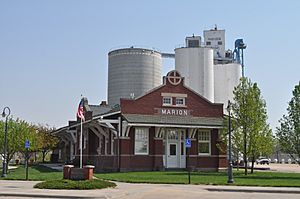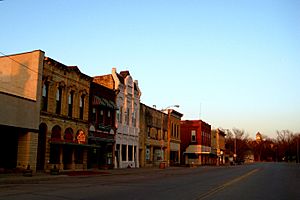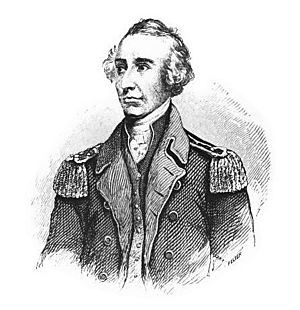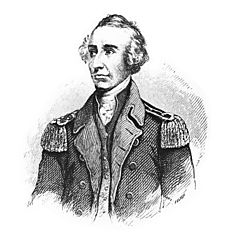Marion, Kansas facts for kids
Quick facts for kids
Marion, Kansas
|
|
|---|---|
|
City and County seat
|
|
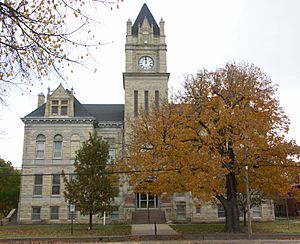
Marion County Courthouse (2009)
|
|

Location within Marion County and Kansas
|
|
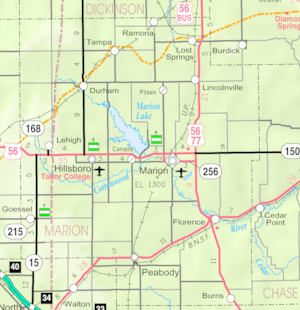
|
|
| Country | United States |
| State | Kansas |
| County | Marion |
| Township | Centre |
| Platted | 1866, 1871, 1873 |
| Incorporated | 1875 |
| Named for | Francis Marion |
| Government | |
| • Type | Mayor–Council |
| Area | |
| • Total | 2.70 sq mi (6.98 km2) |
| • Land | 2.69 sq mi (6.96 km2) |
| • Water | 0.01 sq mi (0.02 km2) |
| Elevation | 1,342 ft (409 m) |
| Population
(2020)
|
|
| • Total | 1,922 |
| • Density | 711.9/sq mi (275.36/km2) |
| Time zone | UTC-6 (CST) |
| • Summer (DST) | UTC-5 (CDT) |
| ZIP code |
66861
|
| Area code | 620 |
| FIPS code | 20-44750 |
| GNIS ID | 485619 |
Marion is a city in and the county seat of Marion County, Kansas, United States. As of the 2020 census, the population of the city was 1,922. The city was named in honor of Francis Marion, a brigadier general of the American Revolutionary War, known as the "Swamp Fox".
History
Early history
For many millennia, the Great Plains of North America was inhabited by nomadic Native Americans. From the 16th century to 18th century, the Kingdom of France claimed ownership of large parts of North America. In 1762, after the French and Indian War, France secretly ceded New France to Spain, per the Treaty of Fontainebleau.
19th century
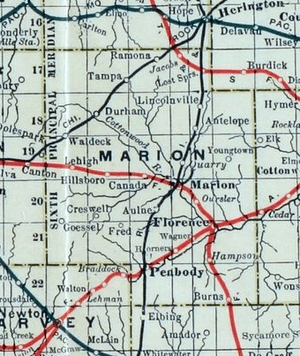
In 1802, Spain returned most of the land to France. In 1803, most of the land for modern day Kansas was acquired by the United States from France as part of the 828,000 square mile Louisiana Purchase for 2.83 cents per acre.
In 1806, Zebulon Pike led the Pike expedition westward from St Louis, Missouri, of which part of their journey followed the Cottonwood River through Marion County near the current cities of Florence, Marion, Durham.
In 1854, the Kansas Territory was organized, then in 1861 Kansas became the 34th U.S. state. In 1855, Marion County was established within the Kansas Territory, which included the land for modern day Marion.
The city of Marion Centre was founded in 1860 and became the county seat. A post office was established in Marion Centre on September 30, 1862 then was renamed to Marion on October 15, 1881. The namesake of the city is Francis Marion.
As early as 1875, city leaders of Marion held a meeting to consider a branch railroad from Florence. In 1878, Atchison, Topeka and Santa Fe Railway and parties from Marion County and McPherson County chartered the Marion and McPherson Railway Company. In 1879, a branch line was built from Florence to McPherson, in 1880 it was extended to Lyons, in 1881 it was extended to Ellinwood. The line was leased and operated by the Atchison, Topeka and Santa Fe Railway. The line from Florence to Marion, was abandoned in 1968. In 1992, the line from Marion to McPherson was sold to Central Kansas Railway. In 1993, after heavy flood damage, the line from Marion to McPherson was abandoned. The original branch line connected Florence, Marion, Canada, Hillsboro, Lehigh, Canton, Galva, McPherson, Conway, Windom, Little River, Mitchell, Lyons, Chase, Ellinwood. Later, the Santa Fe depot building was converted into the Marion Library. Most locals still refer to this railroad as the "Santa Fe".
In 1887, the Chicago, Kansas and Nebraska Railway built a branch line north-south from Herington through Marion to Caldwell. It foreclosed in 1891 and was taken over by Chicago, Rock Island and Pacific Railway, which shut down in 1980 and reorganized as Oklahoma, Kansas and Texas Railroad, merged in 1988 with Missouri Pacific Railroad, and finally merged in 1997 with Union Pacific Railroad. Most locals still refer to this railroad as the "Rock Island".
In 1888, Marion incorporated as a city.
In 1889, the Marion Belt and Chingawasa Springs Railroad built a 4.5-mile (7.2 km) railroad from Marion north-east to Chingawasa Springs. A hotel was built near the site of the spa at Chingawasa Springs, and a depot and eatery as well. Both Santa Fe and Rock Island offered round trip fares from Chicago and western cities to Chingawasa Springs. An economic panic in 1893 closed down the health spa and hotel, and quarry business along the tracks never developed sufficiently. In 1893, the railroad ceased operations, and tracks were removed in 1910.
20th century
The National Old Trails Road, also known as the Ocean-to-Ocean Highway, was established in 1912, and was routed through Lehigh, Hillsboro, Marion and Lost Springs.
In 1937, the Marion County Lake was completed by the Civilian Conservation Corps south-east of Marion for the purpose of recreation. There were numerous floods during the early history of Marion. In June and July 1951, due to heavy rains, rivers and streams flooded numerous cities in Kansas, including Marion. Many reservoirs and levees were built in Kansas as part of a response to the Great Flood of 1951. From 1964 to 1968, the Marion Reservoir was constructed north-west of Marion. Downstream from the Marion Reservoir, levees were built in the low areas of Marion and Florence.
21st century
In 2010, the Keystone-Cushing Pipeline (Phase II) was constructed west of Marion, north to south through Marion County, with much controversy over road damage, tax exemption, and environmental concerns (if a leak ever occurs).
Geography
Marion is located at 38°20′56″N 97°0′58″W / 38.34889°N 97.01611°W (38.348952, -97.016037), in the Flint Hills. According to the United States Census Bureau, the city has a total area of 2.99 square miles (7.74 km2), of which 2.98 square miles (7.72 km2) is land and 0.01 square miles (0.03 km2) is water.
Climate
The climate in this area is characterized by hot, humid summers and generally mild to cool winters. According to the Köppen Climate Classification system, Marion has a humid subtropical climate, abbreviated "Cfa" on climate maps.
Demographics
| Historical population | |||
|---|---|---|---|
| Census | Pop. | %± | |
| 1880 | 857 | — | |
| 1890 | 2,047 | 138.9% | |
| 1900 | 1,824 | −10.9% | |
| 1910 | 1,841 | 0.9% | |
| 1920 | 1,928 | 4.7% | |
| 1930 | 1,959 | 1.6% | |
| 1940 | 2,086 | 6.5% | |
| 1950 | 2,050 | −1.7% | |
| 1960 | 2,169 | 5.8% | |
| 1970 | 2,052 | −5.4% | |
| 1980 | 1,951 | −4.9% | |
| 1990 | 1,906 | −2.3% | |
| 2000 | 2,110 | 10.7% | |
| 2010 | 1,927 | −8.7% | |
| 2020 | 1,922 | −0.3% | |
| U.S. Decennial Census | |||
2020 census
The 2020 United States census counted 1,922 people, 860 households, and 502 families in Marion. The population density was 696.9 per square mile (269.1/km2). There were 971 housing units at an average density of 352.1 per square mile (135.9/km2). The racial makeup was 94.17% (1,810) white or European American (93.08% non-Hispanic white), 0.1% (2) black or African-American, 0.47% (9) Native American or Alaska Native, 0.05% (1) Asian, 0.0% (0) Pacific Islander or Native Hawaiian, 0.26% (5) from other races, and 4.94% (95) from two or more races. Hispanic or Latino of any race was 3.33% (64) of the population.
Of the 860 households, 23.8% had children under the age of 18; 46.4% were married couples living together; 29.8% had a female householder with no spouse or partner present. 37.7% of households consisted of individuals and 21.3% had someone living alone who was 65 years of age or older. The average household size was 2.2 and the average family size was 2.9. The percent of those with a bachelor’s degree or higher was estimated to be 18.4% of the population.
20.3% of the population was under the age of 18, 7.8% from 18 to 24, 20.9% from 25 to 44, 26.3% from 45 to 64, and 24.7% who were 65 years of age or older. The median age was 46.3 years. For every 100 females, there were 114.0 males. For every 100 females ages 18 and older, there were 117.8 males.
The 2016-2020 5-year American Community Survey estimates show that the median household income was $46,548 (with a margin of error of +/- $5,836) and the median family income was $59,028 (+/- $9,025). Males had a median income of $40,000 (+/- $11,143) versus $28,750 (+/- $8,663) for females. The median income for those above 16 years old was $32,826 (+/- $3,144). Approximately, 5.2% of families and 5.5% of the population were below the poverty line, including 4.9% of those under the age of 18 and 4.2% of those ages 65 or over.
2010 census
At the 2010 census, there were 1,927 people, 846 households, and 514 families residing in the city. The population density was 646.6 per square mile (249.7/km2). There were 973 housing units at an average density of 326.5 per square mile (126.1/km2). The racial makeup of the city was 97.6% White, 0.6% African American, 0.3% Native American, 0.1% Asian, 0.1% Pacific Islander, 0.5% from other races, and 0.8% from two or more races. Hispanic or Latino of any race were 1.4% of the population.
There were 846 households, of which 28.6% had children under the age of 18 living with them, 47.3% were married couples living together, 9.6% had a female householder with no husband present, 3.9% had a male householder with no wife present, and 39.2% were non-families. 36.2% of all households were made up of individuals, and 19.5% had someone living alone who was 65 years of age or older. The average household size was 2.23 and the average family size was 2.90.
The median age was 44 years. 24.3% of residents were under the age of 18; 6.6% were between the ages of 18 and 24; 20.5% were from 25 to 44; 25.6% were from 45 to 64; and 23% were 65 years of age or older. The gender makeup was 47.5% male and 52.5% female.
Arts and culture
Area events
- Chingawassa Days Festival
- Old Settler's Day
- Art in the Park and Craft Show
Area attractions
Marion has five listings on the National Register of Historic Places (NRHP).
- Elgin Hotel (NRHP), 115 North 3rd Street. Currently a Bed and Breakfast.
- First Presbyterian Church (NRHP), 610 East Lawrence Street.
- Hill Grade School (NRHP), 601 East Main Street.
- Marion County Courthouse (NRHP), 200 South 3rd Street.
- Marion County Museum, 623 East Main Street. Formerly the First Baptist Church from 1882 to mid-1950s.
Nearby recreational areas:
- Marion County Lake, southeast of Marion, 1-mile (1.6 km) east of Marion on 190th Street (Main) then 1.75 miles (2.82 km) south on Upland Road.
- Marion Reservoir, northwest of Marion, exists along US-56 (closest to farthest): Marion cove and Cottonwood Point cove (Pawnee Road), Overlook and Dam (Old Mill Road), Hillsboro cove (Nighthawk Road), French Creek cove (Limestone Road).
Education
Public schools
The community is served by Marion–Florence USD 408 public school district. The high school is a member of T.E.E.N., a shared video teaching network between five area high schools.
- Marion High School (Kansas), 701 E Main St.
- Marion Middle School, 125 S Lincoln St.
- Marion Elementary School, 1400 E Lawrence St.
Library
Each USD 408 school has a library for student access. The city is served by the Marion City Library at 101 Library Street. The library is a member of the North Central Kansas Libraries System, which provides an inter-library book loan service between its members.
Media
- Marion County Record, official newspaper for City of Marion and Marion County.
- Hillsboro Free Press, free newspaper for greater Marion County area.
Radio
Marion is served by numerous radio stations from the Wichita-Hutchinson listening market area, and satellite radio. (See Media in Wichita, Kansas.)
Television
Marion is served by over-the-air ATSC digital TV of the Wichita-Hutchinson viewing market area, cable TV, and satellite TV. (See Media in Wichita, Kansas.)
Infrastructure
Transportation
U.S. Route 56 runs along the city's northern side, and U.S. Route 77 is 2 miles (3.2 km) east of the city. Kansas Highway 256 runs through the center of town as Main Street, past the east end business section, Marion High School and the downtown business district. A regional Kansas Department of Transportation office is located on the north side of Marion at the corner of U.S. Route 56 and Cedar Street.
The Oklahoma Kansas Texas (OKT) line of the Union Pacific Railroad runs north-south through the city.
Marion Municipal Airport, FAA:43K, is located south-east of Marion and centered at 38°20′15″N 96°59′30″W / 38.337500°N 96.991666°W.
Notable people
- Randolph Carpenter (1894–1956), U.S. Representative from Kansas and a U.S. Army World War I veteran.
- Charlie Faust (1880–1915), Major League baseball player
- Beverly Hoch (born 1951), soprano
- Edward Hoch (1849–1925), Kansas House of Representatives, 17th Governor of Kansas, editor of Marion County Record, Hoch Auditoria at University of Kansas was named after him.
- Homer Hoch (1879–1949), U.S. Congressman, member of Kansas Supreme Court, lawyer, editor of Marion County Record
- Tex Jones (1885–1938), Major League baseball player
- Eric Meyer (born 1953), journalism professor at University of Illinois, Pulitzer Prize nominee, president and majority owner of Hoch Publishing Co (in Marion)
- Fay Moulton (1876–1945), Olympic sprinter, football player and coach, lawyer; served as fifth head football coach at Kansas State Agricultural College (Kansas State University)
- Samuel Peters (1842–1910), Captain in Union Army (1861–1865), lawyer, Kansas State Senator (1874–1875), Judge of 9th District (1875–1883), U.S. House of Representatives (1883–1891), newspaper editor
- William Runyan (1870–1957), preacher, composer of "Great Is Thy Faithfulness"
- Carla Stovall (born 1957), Kansas Attorney General
See also
 In Spanish: Marion (Kansas) para niños
In Spanish: Marion (Kansas) para niños


